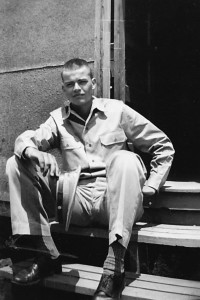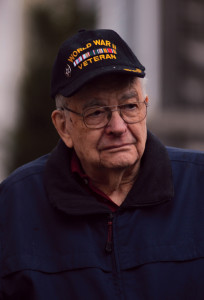by Robert Thompson, 2nd ID (“Indianheads”)
 Who else remembers the great April 1945 POW March from Nuremberg to Stalag VII-A Moosburg? It’s strange how ex-POWs can have sharply different views about the same wartime experience. For me the 100 mile POW march from Stalag XIII-D in Nuremberg to Stalag VII-A in Moosburg in April 1945 was “the best two weeks of captivity”. So much so, that I am taking my family back to Bavaria in April 2016 to retrace this historic POW march with them. (This time, however, not on foot, but traveling in comfort and staying in good hotels.) Why do I feel this way?
Who else remembers the great April 1945 POW March from Nuremberg to Stalag VII-A Moosburg? It’s strange how ex-POWs can have sharply different views about the same wartime experience. For me the 100 mile POW march from Stalag XIII-D in Nuremberg to Stalag VII-A in Moosburg in April 1945 was “the best two weeks of captivity”. So much so, that I am taking my family back to Bavaria in April 2016 to retrace this historic POW march with them. (This time, however, not on foot, but traveling in comfort and staying in good hotels.) Why do I feel this way?
What was so special (about the march)? Well, (1) the end of boredom and confinement, (2) beautiful Bavarian scenery, (3) the friendliness of the German farm families, and (4) and finally, and the most important, was the sudden availability of plenty of food. The Krauts provided bread stations at various places and times along the route, but the primary source of our good fortune was the Red Cross boxes, which also contained Swan soap and cigarettes, which we traded (with the local German frauen) for eggs and other edibles.
But in the Nov/Dec 2015 ‘Ex-POW Bulletin’ of AXPOW (American Ex Prisoners of War Organization), two 8th AF (Airforce) ex-POWs said that “the march was not ‘the best of times’ in captivity”, and “Robert Thompson must have been on a different POW march from Nuremberg to Moosburg, Germany, Stalag VII-A, because my experience was not a scenic tour with plenty of food, guards who let you fall out and join the march a day later, bread stations along the way.”

That’s a big difference in our recollections! What about other ex-POW VBOB veterans on this march? What did you experience?
What I related is not an old veteran vaguely recalling distant wartime memories. It is based on my contemporary wartime diary which I painstakingly kept on scraps of paper and old cigarette packets. Together with my wartime letters to my parents, which my mother faithfully kept, they form a true personal wartime record which I have privately published for my children as part of our family heritage. I can only conclude that the 8th AF POWs were unluckier than me.
I was captured in the Battle of the Bulge in Belgium in December 1944. This ended my time as a 2nd ID (“Indianheads”) combat infantryman, which had begun in Normandy and Brittany in Western France nearly six months earlier. As a POW I traveled six days on foot and by train to my first POW camp, Stalag XIII-C in Hammelburg (between Frankfurt and Nuremberg).
In the neighboring Oflag (officers camp) XIII-B in Hammelburg was Colonel John Waters, General Patton’s son-in-law. In March 1945, a Third Army task force attempted to liberate Oflag XIII-B and Col Waters. But it went disastrously wrong (Patton always denied all knowledge and responsibility). Although we were not aware of the raid, it was enough to persuade the German Army administration to send all of us POWs in Stalag XIII-C by boxcar train from Hammelburg to Stalag XIII-D in Nuremberg, about 90 miles away. This huge camp belonged to the Nazi Party Rallies area, and was originally accommodation for the thousands of SA stormtroopers who participated in the prewar Nuremberg rallies.
Stalag XIII-D in Nuremberg was also the destination of many AF POWs from Stalag Luft III in Sagan (in present day Poland). They had to evacuate Stalag Luft III ahead of the rapid Soviet advance from the east. They certainly had a far longer and harder winter journey on foot and by train than I had from Hammelburg. Then as Patton’s Third Army advanced on Nuremberg from the west, once again the German Army administration ordered us to evacuate Stalag XIII-D and march southwards about 100 miles to Stalag VII-A in Moosburg just north of Munich. It was reputedly the largest POW camp of all.
From what the 8th AF ex-POWs said, the lead group of the march column were AF POWs. They were tragically strafed and bombed just outside Nuremberg by P-47s thinking these AF POWs were German troops on the move until they were identified as POWs. By the time I marched out, the P-47 attacks had fortunately stopped.
The never ending column of POWs was huge (some estimates exceeded 100,000) and the German guards were vastly outnumbered. So, as I recorded in my diary, a simple, strict and effective rule and routine operated, which certainly resulted in making life on the march much more tolerable for the POWs. You can take your time, but stay on the march route and you will be fed. Leave the march route and you will be shot.
It seems very likely that the AF POWs in the lead group of the march column would have been under continual supervision of the guards. So these AF POWs could unfortunately never have enjoyed the much more relaxed conditions farther back in the POW column which I experienced, and which made the march for me “the best two weeks of captivity”. Anyway, I am very much looking forward to taking my family back to this beautiful part of Bavaria to retrace the historic route of this famous POW march, and also to visit places like Munich, Berchtesgaden, Dachau and Salzburg.
One thing is certain. We are going to have a really big welcome and party in Moosburg. Good Bavarian beer will undoubtedly flow. Anita Meinelt, Mayoress of Moosburg, has written me [and she also includes all other ex-POWs, their families and friends]: “It is a great pleasure and honor for us that more than seventy years after the end of a terrible war, former prisoners of war and their families now want to come back as friends. We welcome you most heartily to Moosburg and very much look forward to being able to greet you and receive you in our town.”
If you wish, you are very welcome to join us and other ex-POWs with their families and friends too. For more information on this and other 2016 veterans tours, see POW MARCH COMMEMORATIVE TOUR April 13 – 20, 2016 on Tours page.